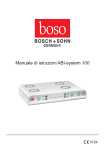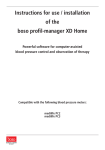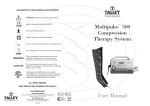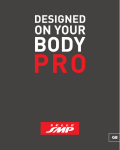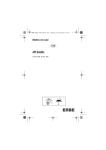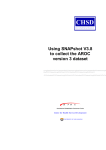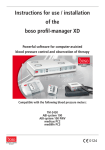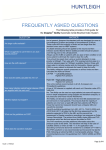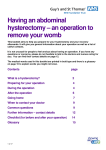Download boso ABI-system 100 Technical data
Transcript
User instructions boso ABI-system 100 and boso ABI-system 100 PWV the powerful system for the early detection of PAD and the determination of the pulse wave velocity (optional) 0124 Table of contents 1. 2. 3. 4. 5. 6. 7. 8. 9. 10. 11. 12. 13. 14. 15. 16. 17. Explanation of symbols and operating controls........................................ 4 Explanation of icons................................................................................ 5 Preliminary remarks................................................................................. 6 Important information............................................................................. 6 Ankle-Brachial Index (ABI)........................................................................ 7 Pulse wave velocity (PWV) . ..................................................................... 7 Turning the device on.............................................................................. 8 Installation and operation of the software............................................... 8 Preparing for an ABI / PWV measurement................................................ 8 Taking and ABI / PWV measurement...................................................... 10 Cleaning the apparatus and cuff............................................................ 12 Disinfecting the apparatus and cuff....................................................... 12 Warranty and customer service.............................................................. 12 Technical data....................................................................................... 12 Instructions for disposal......................................................................... 13 Calibration checks – Testing instructions................................................ 14 EMC notes............................................................................................ 15 2 Contents of package 1 boso ABI-system 100 / boso ABI-system 100 PWV 2 CA04 upper arm cuffs 2 CL04 ankle cuffs 1 boso profil-manager XD 1 USB cable 3,0 m 1 boso power supply unit art. no.: 410-7-154 1 Warranty certificate 1 User instructions boso ABI-system 100 / boso ABI-system 100 PWV 1 User instructions boso profil-manager XD 3 1. Explanation of symbols and operating controls Cuff connection Right arm (colour code red) Cuff connection Left arm (colour code yellow) Cuff connection Right leg (colour code black) Cuff connection Left leg (colour code green) START key Press this key to start a easurement manually. All 4 cuffs will be inflated. STOP key Press this key to cancel an ABI measurement manually. All 4 cuffs will be deflated and the display switched off. Key for starting a single measurement These keys enable the user to start individual measurements of the limbs. Power on indicator The green light is illuminated when power is supplied to the device. To disconnect the instrument from the mains voltage, unplug the AC-adapter from the wall socket. 4 2. Explanation of icons Read the user instructions Protection class II device Degree of protection against electric shock: type BF USB 2.0 connection 0124 The CE mark documents compliance with the Medical Devices Directive 93/42/EEC, Notified body: DEKRA, 0124 Year of manufacture Manufacturer Potential equalisation Do not dispose of this device in the domestic waste. For further information see page 15. 5 3. Preliminary remarks Your boso ABI-system 100 is an innovation on the market of blood pressure measurement technology. It provides a simple way of determining the ankle-brachial index (ABI) and optional pulse wave velocity (PWV). The pressure variations (oscillations) caused by pulse waves and transmitted by the cuffs are stored and evaluated by microprocessors. The great advantage of this type of measurement is that there is no need for a microphone or amplifier which must be positioned exactly if accurate results are to be obtained. This system complies with the European directives on which the German Medical Devices Act (CE mark: CE0124) is based and with European Standard EN 1060, Part 1: “Non-invasive sphygmomanometers - General requirements” and Part 3: “Supplementary requirements for electro-mechanical blood pressure measuring systems”. Calibration checks - every 2 years at the latest - can be performed either by the manufacturer, or the trade measurement authorities, or persons who fulfil the requirements of the legislation governing the operation of medical devices (German Medical Devices Operator Ordinance section 6). Instructions for calibration checks can be found on page 14 of these user instructions. Medical electrical apparatuses are subject to specific precautions as regards electromagnetic compatibility and must therefore be installed and operated according to the EMC instructions given on page 15. 4. Important information • The same exclusion criteria apply for oscillometric ABI measurements as for Doppler measurements. • Cardiac arrhythmias can interfere with the accuracy of a measurement and produce incorrect readings. Interference can also occur in wearers of pacemakers if they have a weak pulse. The blood pressure monitor will have no effect on the pacemaker, however. • The device is suitable for patients of all ages, whose upper arm circumferences are between 22 and 48 cm and ankle circumferences are between 18 and 38 cm. • The device is not suitable for newborn babies. • Do not use the apparatus in patients with severe heart failure. • Do not use the apparatus unattended in unconscious, helpless or unresponsive persons. • Do not place the cuffs over open wounds, implanted stents or lymphoedema. • Allow an interval of at least 2 minutes between 2 consecutive measurements. • Make sure that the tubes are not kinked during the measurement. A congestion 6 could lead to injuries. • During measurement the flow of blood must not be stopped any longer than necessary (> 2 minutes). In case of a malfunction of the device, take off the cuffs from the arms and legs. • Too many measurements may lead to impairment of blood flow and thus to injries. • The cuff should not be applied on wounds, as this may cause further injuries. • Make sure the cuff is not applied to an arm or leg which arteries or veins are or have been under medical treatment (e.g. shunt). • Women with mastectomy should not have a cuff on the arm at the side where the breast has been amputated. • During the measurement, a malfunction may occur in other medical devices which are applied simultaneously on the same arm. • Operating the device in the vicinity of strong electromagnetic fields (e.g. radiation devices, mobile phones) can cause it to malfunction (see page 15). • The computer used for the analysis must meet the requirements of EN 60601-1. • If the instrument is to be sold, ensure that these user instructions are enclosed. 5. Ankle-Brachial Index (ABI) To determine the ABI value, the systolic blood pressure values of the arms and legs must be measured. Blood pressure measurement values are given in mmHg (mm of mercury). The ABI is calculated as a quotient of the systolic pressure of the leg measurement (the mean pressure of the posterior and anterior tibial arteries) and the higher systolic pressure of the arm measurements. 6. Pulse wave velocity (PWV) (optional) The pulse wave velocity is calculated using the pulse transit time between upper arm and ankle, and body size. The measured values are given in m / s (meters per second). 7 7. Turning the device on The mains connection socket is located at the rear of the device. Use only the boso power supply unit (order no. 410-7-154), as it produces a rectified output of the correct polarity. Other commercially available power supply units can cause damage to the electronic components, which will invalidate the warranty. To establish the potential equalization connect an appropriate wire to the relevant potential compensation of the unit. Furthermore the requirements of EN 606011:2006 apply for potential compensation. The bonding conductor shall not be used as a protective conductor connection. 8. Installation and operation of the software of the ABI-system 100 see user instruction / installation guide of boso profil-manager XD 9. Preparing for an ABI / PWV (optional) measurement The measurement must be performed with the patient supine to ensure comparable blood pressure conditions in arms and legs. The legs must not be crossed. The patient should rest for about 5 minutes before a measurement is taken. Attaching the cuff The device should only be used with original boso CA04 or CL04 cuffs Type Circumference Order no. Upper arm cuff CA04 Upper arm cuff CA02 22 - 42 cm 32 - 48 cm 143-4-768 143-4-771 Ankle cuff CL04 18 - 38 cm 143-4-769 8 The cuffs are colour-coded. Attach the individual cuffs to both upper arms and both ankles according to their colour coding (matching the symbols next to the air connection sockets on the apparatus). Attach the upper arm cuffs so that the lower edge of the cuff is about 2-3 cm above the elbow joint. The cuff should be positioned in such a way that the marking is over the brachial artery. Never place the metal ring over arteries, as this may produce an incorrect reading. Attach the ankle cuffs so that the lower edge of the cuff is about 1-2 cm above the ankle joint. The cuff should be positioned in such a way that the white marking is over the posterior tibial artery. Ensure that the cuff fits tightly at the ankle. Assignment of cuffs to limbs. Check that the cuffs are correctly assigned to the individual limbs by individual measurements of the right or left arm and right or left leg. 9 10. Taking an ABI / PWV (optional) measurement A measurement can be cancelled at any time by clicking on the "Cancel measurement" button in the software or pressing the STOP key on the apparatus; all the cuffs deflate automatically. Alternatively, the cuffs can be removed from the limbs at any time. Select “Start new measurement” in the “Measurements” tab or press the START button on the apparatus. The ABI-system 100 starts the ABI measurement after a short calibration process (about 3 seconds). The apparatus has an intelligent automatic inflation system to ensure comfortable inflation to the correct cuff pressure. When the correct inflation pressure has been reached, the pump will switch off and the cuffs will deflate automatically. At this point (if not before) the patient must keep all four limbs completely still and may not talk. (optional) Select "ABI + PWV measurement" in the registry "data" or press the START button on the unit. The ABI-system 100 starts the ABI measurement after a short calibration procedure (about 3 seconds). Upon completion of the ABI measurement and another break (about 10 seconds) the PWV measurement is started. After the measurement the valves are opened automatically to allow rapid deflation of the cuffs. The measured values are displayed in the profilmanager XD. 10 Individual comments can be added for each ABI measurement via the "Remarks..." button. Templates can be defined and stored for later usage. Saving an ABI / PWV (optional) measurement To save an ABI measurement, select "Save measurement". The measurement must be repeated if the results are obviously wrong Blood pressure is a dynamic parameter and can be influenced by various effects: - movement before or during the measurement - physical condition (stress, illness ...) Repeating an ABI / PWV (optional) measurement Allow an interval or at least 2 minutes between successive measurements. To repeat an ABI measurement select "ABI measurement" or "ABI + PWV measurement". To take a measurement on one limb only, press the START key next to the corresponding symbol. When determining the ABI it is recommended to perform all measurements at the same time. If no further measurement is required, remove the cuffs from the limbs. 11 11. Cleaning the apparatus and cuff Please use only a soft, dry cloth to clean the device. Small stains on the cuff can be carefully removed with a damp cloth. 12. Disinfecting the apparatus We recommend Antifect® Liquid disinfectant (Schülke&Mayr) to wipe the apparatus and cuffs for disinfection. 13. Warranty and customer service For details of the warranty conditions, please consult the warranty certificate supplied. A claim under warranty will only be accepted if the warranty certificate, completed and stamped by the dealer, is returned with the device. For warranty and repair work, please send the device, carefully packaged and with sufficient postage, to your authorised dealer or directly to: BOSCH + SOHN GmbH u. Co. KG Bahnhofstraße 64 D-72417 Jungingen Maintenance on this device must be done by trained and authorized personnel only. The instrument must not be modified without permission of the manufacturer. 14. Technical data Measurement principle: oscillometric Measurement range: 60 to 240 mmHg Cuff pressure: 0 to 300 mmHg Maximum deviation of cuff pressure measurement: ± 3 mmHg (max. difference right/left ± 2 mmHg) Measurement range puls: 30 to 190 puls/min. 12 Maximum deviation of puls measurement: ±5% Maximum deviation of PWV measurement: ±5% Operating conditions: Environmental temperature +10 to +40°C Relative humidity 30 to 85% Transport and storage conditions: Environmental temperature -10 to +60°C Relative humidity 30 to 85% Power supply: DC 5 V power supply unit, 2.7 A, AC 100240 V, 50-60 Hz, order no.: 410-7-154 Weight: 3.7 kg without power supply unit Dimensions (W x H x D): 460 mm x 83 mm x 290 mm Classification: Clinical test (DIN 58130): Protection class II (Symbol Type BF (Symbol : ) ) accuracy complies with the requirements of EN 1060 part 3 Subject to technical modifications. 15. Instructions for disposal This apparatus falls within the scope of EC Directive 2002/96/EC (WEEE). It is not registered for use in private households and disposal via communal collection sites for obsolete electrical apparatus is prohibited. Bosch + Sohn has commissioned a company to dispose of the apparatus safely and legally. Please refer to the address mentioned at the end of these user instructions for further information. 13 16. Calibration checks – Testing instructions Function testing Function testing of the device can only be carried out on a person or with a suitable simulator. Testing of pressure circuit integrity and deviation of pressure display 1.) Use the "Pressure sensors A"or "Pressure sensors B" button in sub-registry "Test mode" to start the test mode. 2.) After a short calibration process the apparatus will be in test mode. The current pressure will be displayed in the corresponding boso profil-manager XD fields. 3.) Perform the usual test for deviation of pressure display and pressure cir cuit integrity (allow a set-up time of at least 30 seconds for the cuff). Maximum difference of the pressure right - left ± 2 mmHg. 4.) Run the test for all 4 limbs. 5.) Exit test by pressing the “Finish test” button. The activation of the “presure sensors B” is only possible for devices with a serial number upper 466 20000. Safety seal As a safeguard, the upper and lower parts of the housing can be joined with a safety seal. The unauthorized destruction of the hedging mark voids the warranty. (optional) The testing of the "PWV"-function requires specialized simulators and must be done by the manufacturer. 14 17. EMC notes for boso ABI-system 100 EMC-notes for your ABI-system 100 Medical Electrical Equipment needs special precautions regarding EMC and needs to be installed and put into service according the EMC information provided in the following. Portable and mobile RF communication equipment (e.g. cell phones) can affect Medical Electrical Equipment. The use of accessories and cables other than those specified (other than boso original parts) may result in increased emissions or decreased immunity of the unit. Guidance and manufacturer’s declaration – electromagnetic emissions The boso unit is intended for use in the electromagnetic environment specified below. The customer of the user of the boso unit should assure that it is used in such an environment. Emissions test Compliance Electromagnetic environment – guidance RF emissions CISPR 11 Group 1 The boso unit uses RF energy only for its internal function. Therefore, its RF emissions are very low and are not likely to cause any interference in nearby electronic equipment. RF emissions CISPR 11 Class B Harmonic emissions IEC 61000-3-2 Class A The boso unit is suitable for use in all establishments, including domestic establishments and those directly connected to the public low-voltage power supply network that supplies buildings used for domestic purposes. Voltage fluctuations/flicker emissions IEC 61000-3-3 Complies Guidance and manufacturer’s declaration – electromagnetic immunity The boso unit is intended for use in the electromagnetic environment specified below. The customer or the user of the boso unit should assure that it is used in such an environment. Immunity test IEC 60601 test level Compliance level Electrostatic discharge (ESD) IEC 61000-4-2 ± 6 kV contact ± 6 kV contact ± 8 kV air ± 8 kV air Electrical fast transient/burst IEC 61000-4-4 ± 2 kV for power supply lines ± 2 kV for power supply lines ± 1 kV for input/output lines ± 1 kV for input/output lines Surge IEC 61000-4-5 ± 1 kV differential mode ± 1 kV differential mode ±2 kV common mode ±2 kV common mode < 5% UT (> 95% dip in UT) for 0,5 cycle < 5% UT (> 95% dip in UT) for 0,5 cycle 40% UT (60% dip in UT) for 5 cycles 40% UT (60% dip in UT) for 5 cycles 70% UT (30% dip in UT) for 25 cycles 70% UT (30% dip in UT) for 25 cycles < 5% UT (> 95% dip in UT) for 5 s < 5% UT (> 95% dip in UT) for 5 s 3 A/m 3 A/m Voltage dips, short interruptions and voltage variations on power supply input lines IEC 61000-4-11 Power frequency (50/60 Hz) magnetic field IEC 61000-4-8 Electromagnetic environment – guidance Floors should be wood, concrete or ceramic tile. If floors are covered with synthetic material, the relative humidity should be at least 30%. Mains power quality should be that of a typical commercial or hospital environment. Mains power quality should be that of a typical commercial or hospital environment. Mains power quality should be that of a typical commercial or hospital environment. If the user of the boso unit requires continued operation during power mains interruptions, it is recommended that the boso unit has to be powered from a uninterruptible power supply or a battery. NOTE : UT is the a.c. mains voltage prior to application of the test level. 15 Guidance and manufacturer’s declaration – electromagnetic immunity The boso unit is intended for use in the electromagnetic environment specified below. The customer or the user of the boso unit should assure that it is used in such an environment. Immunity test IEC 60601 test level Compliance level Electromagnetic environment – guidance Portable and mobile RF communications equipment should be used no closer to any party of the boso unit, including cables, than the recommended separation distance calculated from the equation applicable to the frequency of the transmitter. Recommended separation distance: Conducted RF IEC 61000-4-6 3 V rms 150 kHz to 80 MHz 3 V rms d = 1,2 Radiated RF IEC 61000-4-3 3 V/m 80 MHz to 2,5 GHz 3 V/m d = 1,2 P 80 MHz to 800 MHz d = 2,3 800 MHz to 2,5 GHz P P where P is the maximum output power rating of the transmitter in watts (W) according to the transmitter manufacturer and d is the recommended separation distance in metres (m). Field strengths from fixed RF transmitters, as determined by an electromagnetic site survey, a should be less than the compliance level in each frequency range.b Interference may occur in the vicinity of equipment marked with the following symbol: NOTE 1 At 80 MHz and 800 MHz, the higher frequency range applies. NOTE 2 These guidelines may not apply in all situations. Electromagnetic propagation is affected by absorption and reflection from structures, objects and people. a Field strengths from fixed transmitters, such as base stations for radio (cellular/cordless) telephones and land mobile radios, amateur radio, AM and FM radio broadcast and TV broadcast cannot be predicted theoretically with accuracy. To assess the electromagnetic environment due to fixed RF transmitters, an electromagnetic site survey should be considered. If the measured field strength in the location in which the boso unit is used exceeds the applicable RF compliance level above, the boso unit should be observed to verify normal operation. If abnormal performance is observed, additional measures may be necessary, such als re-orienting or relocating the boso unit. b Over the frequency range 150 kHz to 80 MHz, field strengths should be less than 3 V/m. Recommended separation distances between portable and mobile RF communications equipment and the boso unit The boso unit is intended for use in an electromagnetic environment in which radiated RF disturbances are controlled. The customer or the user of the boso unit can help prevent electromagnetic interference by maintaining a minimum distance between portable and mobile RF communications equipment (transmitters) and the boso unit as recommended below, according the the maximum output power of the communications equipment. Separation distance according to frequency of transmitter m Rated maximum output power of transmitter W 150 kHz to 80 MHz 80 MHz to 800 MHz 800 MHz to 2,5 GHz 0,01 0,1 1 10 100 d = 1,2 P 0,12 0,38 1,2 3,8 12 d = 1,2 P 0,12 0,38 1,2 3,8 12 d = 2,3 P 0,23 0,73 2,3 7,3 23 For transmitter rated at a maximum output power not listed above, the recommended separation distance d in metres (m) can be estimated using the equation applicable to the frequency of the transmitter, where p is the maximum output power rating of the transmitter in watts (W) according the the transmitter manufacturer. NOTE 1 At 80 MHz and 800 MHz, the separation distance for the higher frequency range applies. NOTE 2 These guidelines may not apply in all situations. Electromagnetic propagation is affected by absorption and reflection from structures, objects and people. 16 Your notes: 17 Your notes: 18 Your notes: 19 Subject to change without prior notification. Omissions and errors excepted. (07/05/2014) BOSCH + SOHN GmbH u. Co. KG Bahnhofstraße 64 • 72417 Jungingen • Germany Phone: +49 (0) 74 77 / 92 75-0 • Fax: +49 (0) 74 77 / 10 21 www.boso.de • mail: [email protected]






















